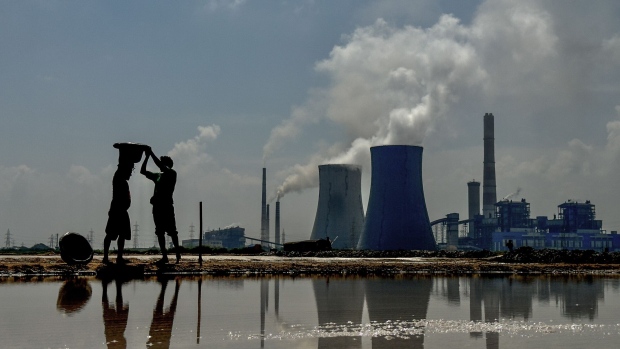Economy
Dialogue NB Seeks To Rebuild An Inclusive Economy Through Conversation – Huddle – Huddle Today
MONCTON – Dialogue NB CEO Nadine Duguay-Lemay says the business community has an integral place in a conversation about building a more equal and just New Brunswick.
That very conversation will take place on September 27 in Moncton with Dialogue Day 2021.
“When we talk about anti-racism, notions of equality, diversity, acceptance and inclusion and all those notions we celebrate, it’s not something we can do on our own,” said Duguay-Lemay.
“The business community actively needs to participate, if anything, because those topics concern them. That’s why you see so many business support the event.”
The volunteer-led non-profit organization plans to host an inclusive conversation on Monday at Moncton’s Crowne Plaza and virtually, online.
Dedicated to building social cohesion in New Brunswick, the sold-out event will feature discussions about racial justice in the workplace, rethinking the economy as it recovers from the pandemic and how to be a better ally to Indigenous people.
The event, which has sold out of in-person seats, will feature Jeremy Dutcher, a Wolastoq singer, songwriter, composer, musicologist and activist from Tobique First Nation, as its keynote speaker.
The mandate of the discussions is to ensure everyone feels heard, valued and that they belong, making diversity an asset – something Duguay-Lemay considers imperative to a functional economy.
“What I’ve found is that people don’t like to go into uncomfortable discussions. Some people want to embrace social cohesion but don’t know where to start, or are afraid of saying the wrong thing. This is our expertise – we’re good at the art of dialogue and multiple viewpoints at one table,” she said.
“We need a lot of different voices and perspectives at the table to rethink the system for the wellbeing of all. These discussions shouldn’t be happening in isolation.”
Duguay-Lemay said New Brunswick faces many economic challenges, noting a diverse workforce will help recover from those challenges.
She stressed that the business community needs to work toward a goal of truth and reconciliation, and in a call with Huddle, rebutted the metaphor of everyone being on the same boat during the pandemic.
“I’d argue we’re all facing the same storm, but not in the same boat. Some people are in yachts and some are in little boats about to capsize,” she said.
Other voices are emerging – female and Indigenous, for example – looking to address poverty and wage inequality and unfairness, employment access, systemic racism and environmental degradation, noted Duguay-Lemay, adding that the province’s 4,418 non-profits need more recognition as an economic partner.
“Inclusion is embedded in our DNA as Canadians. We’re already a country and province that abides by those laws, so it’s important to look at inclusion,” she said.
The conversations will also focus on racial justice in the workplace, how the pandemic hurt Indigenous and black Canadian employment, versus non-minorities, access to employment – and the social barriers that exist for racialized workers.
“I invite all organizations, employers, public and non-profits to look at their practices in place and ask if they walk the talk for truth and reconciliation. We’re all treaty people – how do we uphold this?” said Duguay-Lemay.
“We want to at least demonstrate to Indigenous people in New Brunswick that we hear their plight and are serious about truth and reconciliation.”
Greater social cohesion is the best step forward, Duguay-Lemay noted, adding that real dialogue can build an economy that works for everyone.
She said matters of racial justice in the workplace – and specific matters, such as owners objecting to the declaration of September 30 as a statutory holiday, contending that they can’t afford it – will be among the economic issues for which solutions will be sought.
The conversation will also focus on how the province’s recovery from the pandemic has exposed inequalities in the economy.
Duguay-Lemay stressed the need to learn from the way the pandemic exposed inequalities, and rethink a system that works for everyone.
“We need to think differently and it really shouldn’t be based on the interests of the privileged,” said Duguay-Lemay.
“As employers are looking to attract and retain talent, we hear about skill shortages all the time. This becomes a matter of attracting talent, whether from newcomers or tapping into Indigenous communities, how can we make our workplaces more equitable and inclusive?
The event will feature an “eclectic” round table of specialists, artists, activists and experts from numerous sectors, and identities in New Brunswick, with opportunities for networking, inspiration for change with concrete examples and skills to help become a social leader.
Economy
Israeli economy has proven to thrive despite crisis: Expert – Yahoo Canada Finance
Over the weekend, Iran launched a direct attack on Israel. Although Israel successfully intercepted the drones and missiles, the potential for an Israeli retaliation remains uncertain. David Blumberg of Blumberg Capital joins Yahoo Finance to discuss the state of the Israeli economy in light of these developments.
Blumberg claims that Israelis are “somewhat used to these types of things.” Blumberg notes that over the past 25 years, the country has weathered numerous crises, but has achieved consistent growth. He points to Israel’s GDP per capita of $54,000, which exceeds that of some of the world’s largest economies, as evidence of the economy’s ability to “thrive despite and through downturns.”
For more expert insight and the latest market action, click here to watch this full episode of Market Domination Overtime.
This post was written by Angel Smith
Video Transcript
JOSH LIPTON: Over the weekend, Iran launched its first ever direct attack on Israel with a salvo of hundreds of drones and missiles. David Blumberg is currently in Israel where his venture capital firm Blumberg Capital has offices and investments. David joins us now for more on the state of the Israeli economy and tech community. David, it is great to see you and have you on the show.
ADVERTISEMENT
DAVID BLUMBERG: Thank you so much, Josh. Great to see you as always.
JOSH LIPTON: So David, you’re in Israel now. You were obviously there over the weekend during this Iranian attack. So David, I just first want to know how you’re doing.
DAVID BLUMBERG: You can see I’m fine. I’m happy. I feel safe.
With my team here on the ground, we had a meeting with about 20 of our portfolio companies last night. We did it by Zoom instead in meeting. But people are very resilient here.
The streets, you can’t see them. They’re full of people at restaurants. The clubs are– the clubs are busy, traffic jams happening.
It’s remarkable how normal it is in a time when, I think, in America or other places, if this happened, people would be really freaking out. Israelis are unfortunately somewhat used to these kinds of things. This is the most severe it’s ever been. But they really did a great job with the Americans, the British, and the Jordanians, and French to knock down 99.9% of all the projectiles. So I think people feel like they won this battle.
JOSH LIPTON: And so David, the Israeli people a resilient community. At the same time, you know, David, they are engaged in this three-front war. It’s Iran. It’s Hamas to the south. It’s Hezbollah to the north.
It’s an enormous economic burden for the country, David. You just think of soldiers being called up and the tens of thousands of Israelis displaced in the north because of Hezbollah. How does the economy sustain this, David?
DAVID BLUMBERG: Well, I like to always look for history, Josh. So as we recall, over the last 25 years, there have been four or five war conflict situations plus COVID plus the dotcom crash plus a number of other financial crises, et cetera. So if we look at that, we see that over those 25 years, the Israeli GDP per capita measure of productivity of every individual working grew 2% to 3% faster than OECD countries during that same period pretty consistently.
Now, there were downturns and then they’ve come back. But over time, you see this growth. And in fact, I was looking at the data recently, in 2023, Israel achieved GDP per capita of $54,000. Now, that is higher than France, higher than the UK, and higher than Japan, which surprised me to see that growth. Because Israel, when I first started coming here, was a much poorer country.
But the tech boom in particular has really bolstered the economy. And as you’re asking, it seems to thrive despite and through downturns. There are downturns here, but the next year they get stronger.
Economy
Coal Keeps Powering India as Booming Economy Crushes Green Hopes – BNN Bloomberg


(Bloomberg) — Built along a stretch of salt flats in southern India, the Tuticorin power plant epitomizes a quagmire for the world’s fastest-growing major economy: how to provide reliable energy to 1.4 billion people.
For starters, the 1,050-megawatt coal plant, one of the region’s largest, was supposed to shut down. Opened four decades ago, the facility is too cramped to install retrofits to meet the government’s pollution norms, prompting India’s power ministry to plan its closure by 2022. Yet the facility continues to run at full blast, clocking 90% utilization in February. Aging boilers guzzle coal from mines nearly 2,000 kilometers away — a transport distance that only adds to the nation’s emissions footprint.
Electricity consumption in India is growing at the fastest rate of any major economy, driven by rising temperatures and incomes, which have pushed up sales of power-intensive appliances like air conditioners. That explosive equation has exposed the country’s teetering grid. Though Prime Minister Narendra Modi has promised to rapidly build out solar and wind generation to replace polluting fossil fuels, his administration hasn’t been able to keep up with demand, giving a second life to old, inefficient coal plants like the one in Tuticorin.
In recent months, Modi has green-lit a fresh wave of power station development and extended the lifespan of many existing coal assets. It’s a decision that puts India at odds with global allies who’re shunning the fuel on climate grounds, threatening Modi’s ambitions to curb air pollution and reduce the world’s third-largest share of greenhouse gas emissions.
Those dynamics will also hand the nation a crucial role in dictating the speed of the world’s retreat from coal. Demand in China, currently the top consumer, probably peaked last year and the rate of future growth will increasingly be driven by India and Southeast Asia’s rising economies, according to the International Energy Agency.
“The message is clear to both the international and domestic audiences: We’re all in for climate actions, but India’s domestic interests will take priority,” said Ashwini K. Swain, a fellow at Sustainable Futures Collaborative, a climate think tank in New Delhi.
India’s power ministry and Tamil Nadu Generation and Distribution Corp., which runs the Tuticorin coal plant, didn’t respond to requests for comment.
India has a long way to go to ensure reliable and affordable electricity. In Oct. 2021, the country was hit by a massive coal and power crisis, just as the economy began to emerge from the Covid-19 pandemic. Years of weak demand had led to sluggish growth in mining, transportation and power generation capacities.
Soon after the situation improved, officials realized the crisis wasn’t a blip. Energy demand rose to a new high the following summer, causing the worst supply shortages in eight years. In 2023, even though that squeeze eased at the national level, Maharashtra, one of India’s most industrialized states and home to its financial capital Mumbai, faced an alarming 10% peak deficit in August.
While shortages raised expectations that the country would accelerate the shift to green energy, India’s response was exactly the opposite. Officials pushed for more mining, abandoned plans to retire old power plants, raised targets to add coal-fired electricity and successfully lobbied international forums to adopt resolutions that wouldn’t hinder fossil fuel use.
“As a country, we should play to our strength, and coal is our strength,” said Prakash Tiwari, a former operations director at state-run NTPC Ltd., the nation’s largest power producer.
Alternative energy solutions haven’t yet caught on for financial, political and safety reasons.
More than 35 miles from Tuticorin, a dusty road leads to two solar power plants surrounded by sprawling wind parks. Ayana Renewable Power, which runs one of the facilities, sees a future in renewable power with energy storage to serve industrial users. That trend is rising in India, although far from becoming a source of mass power supplies. Solar accounted for 6% of generation in 2023, according to Bloomberg calculations based on power ministry data.
State-run power producer NLC India Ltd., which runs the other plant, is committing more than twice as much money to expanding mining, coal and lignite-fired power capacity than to building renewables, according to Chairman M. Prasanna Kumar.
Natural gas, pushed by producers as a less-polluting alternative to coal, has also struggled to compete. Nearly 25 gigawatts of gas-fired power capacity has been idling for years, priced out by other power sources, including coal. India doesn’t have enough domestically produced subsidized fuel to run the plants and operating these assets on imported liquefied natural gas is often too costly in India’s price-competitive electricity market.
Building hydropower dams is also fraught. Most of India’s potential there is locked in the fragile Himalayan region, where frequent extreme weather events, such as flash floods, jeopardize projects. The risks have galvanized local opposition against large dams, delaying plans by years and adding to costs that have rendered many of them unpalatable.
Nuclear power has seen a revival in many parts of the world for its low-emissions energy. But there, too, the industry in India has moved too slowly to make a mark and questions about safety persist. The nation’s nuclear liability law holds vendors and suppliers responsible for accidents. Many are still haunted by the Bhopal gas tragedy of 1984, which killed thousands of people exposed to toxic chemicals.
Consider Kudankulam, about 90 miles south of Tuticorin. The site hosts two reactors of 1 gigawatt each and four more are being added. In the nearby village of Idinthakarai, 52-year-old Mildred, who goes by one name, has been at the forefront of protesting the plant’s construction. She’s traveled across the country to discuss the risks of nuclear energy.
“Why can’t these be our main source of energy?” the activist asked on a recent day, pointing to a few rotating wind turbines near her home.
In 2008, India struck an agreement with the US to share nuclear technology and fuel, clearing the runway for new projects. India has also signed deals with foreign reactor suppliers, including General Electric-Hitachi, Westinghouse Electric Corp. and Areva SA, which later transfered the project to state-run peer Electricite de France SA. GE-Hitachi has since backed out, citing the liability law.
In the western state of Maharashtra, India had planned to build the world’s largest nuclear power plant, a mammoth 9.6 gigawatts facility near sprawling Alphonso mango orchards.
But locals resisted selling their land when Kiran Dixit, then an executive director of the state monopoly Nuclear Power Corp. of India Ltd., visited the area.
They thought prices were too low and worried that the plan would harm the livelihood of fishermen and the mango trees. The company tried to put those fears to rest and the land was eventually acquired, Dixit said. Still, the Jaitapur project has yet to significantly break ground as the two sides continue to discuss terms of the deal.
©2024 Bloomberg L.P.
Economy
Global Economy Soft Landing Masks Growing Debt, Inequality
|
|


The increasingly hopeful economic story of 2024 so far is that of a world headed for a soft landing. Unfortunately that same world is also becoming more dangerous, divided, indebted and unequal.
The reasons for short-term optimism are plain. A resilient US economy has defied expectations that the Federal Reserve’s barrage of interest-rate hikes would induce a recession. The UK—which dipped into a downturn at the end of last year—is already growing again, and Germany’s industrial sector is showing signs of a turnaround. Even in debt-hobbled China, domestic tourists spent more per trip over the Lunar New Year holiday than in 2019 for the first time since the pandemic, and the nation’s factories are humming a little more loudly.





-
Media15 hours ago
DJT Stock Plunges After Trump Media Files to Issue Shares
-
Business14 hours ago
FFAW, ASP Pleased With Resumption of Crab Fishery – VOCM
-
Media14 hours ago
Marjorie Taylor Greene won’t say what happened to her Trump Media stock
-



 Tech22 hours ago
Tech22 hours agoHow funny? Australian researchers use AI to generate cartoon captions – Digital Journal
-
Business15 hours ago
Javier Blas 10 Things Oil Traders Need to Know About Iran's Attack on Israel – OilPrice.com
-
Media13 hours ago
Trump Media stock slides again to bring it nearly 60% below its peak as euphoria fades – National Post
-
Business20 hours ago
A government mortgage policy that makes sense – with one glaring question – The Globe and Mail
-
Media16 hours ago
Trump Media Plunges After Registering Shares, Warrants for Sale – BNN Bloomberg






